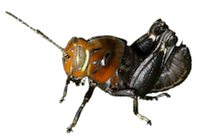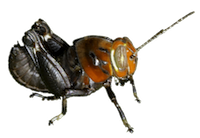Family (Alpha): ACRIDIDAE GRYLLACRIDIDAE GRYLLIDAE GRYLLOTALPIDAE RHAPHIDOPHORIDAE ROMALEIDAE TETRIGIDAE TETTIGONIIDAE TRIDACTYLIDAE
View Tettigoniidae Members:
Conocephalus aigialus Conocephalus allardi Conocephalus brevipennis Conocephalus fasciatus Conocephalus nemoralis Conocephalus nigropleuroides Conocephalus saltans Conocephalus spartinae Conocephalus stictomerus Conocephalus strictus Conocephalus unidentified species Odontoxiphidium apterum Orchelimum agile Orchelimum bradleyi Orchelimum campestre Orchelimum carinatum Orchelimum concinnum Orchelimum erythrocephalum Orchelimum fidicinium Orchelimum militare Orchelimum minor Orchelimum nigripes Orchelimum pulchellum Orchelimum superbum Orchelimum vulgare Orchelimum unidentified species Belocephalus subapterus Bucrates malivolans Neoconocephalus bivocatus Neoconocephalus caudellianus Neoconocephalus ensiger Neoconocephalus exiliscanorus Neoconocephalus melanorhinus Neoconocephalus palustris Neoconocephalus retusus Neoconocephalus robustus Neoconocephalus triops Neoconocephalus velox Neoconocephalus unidentified species Pyrgocorypha uncinata Amblycorypha alexanderi Amblycorypha arenicola Amblycorypha peedee Amblycorypha carinata Amblycorypha floridana Amblycorypha longinicta Amblycorypha oblongifolia Amblycorypha rotundifolia Amblycorypha unidentified species Microcentrum retinerve Microcentrum rhombifolium Montezumina modesta Inscudderia walkeri Scudderia unidentified species Scudderia cuneata Scudderia curvicauda Scudderia curvicauda laticauda Scudderia fasciata Scudderia furcata Scudderia septentrionalis Scudderia texensis Pterophylla camellifolia Atlanticus americanus Atlanticus gibbosus Atlanticus monticola Atlanticus pachymerus Atlanticus unidentified species Hubbellia marginifera Atlanticus davisi Amblycorypha uhleri group NC Records
Amblycorypha peedee Forrest, 2023 - Pee Dee Round-winged Katydid
No image for this species.
Taxonomy
Family: Tettigoniidae
Subfamily: PhaneropterinaeTribe: AmblycoryphiniSynonym: Amblycorypha bartrami Comments: One of seventeen species in this genus that occur in North America (Cigliano et al., accessed 2024-09-25; Forrest et al., 2023). Eight species have been recorded in North Carolina.Species Status: Belongs to Amblycorypha Group II of Rehn and Hebard (1914) and the Rotundifolia Species Group as revised by Walker et al. (2003). Members of this group are characterized by the shallow humeral sinus of the pronotum; transverse metastermal lobes that are wider than long; and a less strongly arcuate posterior margin of the pronotum. In addition to A. rotundifolia , this group includes A. alexanderi and the recently described Amblycorypha peedee in North Carolina.
Identification
Field Guide Descriptions: Online Photographs: BugGuide , Google Images ,
iNaturalist , GBIF Comments: Green, with only the stridulatory field of the males marked with brown. Species of this group are distinguished by the songs of the males.Structural photos
Singing Behavior: According to Forrest et al. (2023), syllables are almost always produced in doublets with syllable
rates within doublets of about 11.6 per sec at 25°C and rates of 4.0 per sec between doublets at 25°C. The sustained portion of calling songs of A. peedee has about 17 syllables, with 2–3 syllables in each of the series preceding the sustained portion.
Distribution in North Carolina
County Map: Clicking on a county returns the records for the species in that county.
Adult Dates: Click on graph to enlarge
Habitats and Life History
Habitats: Xeric sandhills woodlands and scrub (Forrest et al., 2023). Diet: Observation Methods: Probably best detected by the songs of the males. Can also be collected by sweep-netting or by direct search at night.Abundance/Frequency: Adult Phenology:
Status in North Carolina
Natural Heritage Program Status: [W3]Natural Heritage Program Ranks: S1S2State Protection: This species currently has no formal protection in North Carolina, although permits are needed to collect it on state parks or game lands.Comments: This recently described species is believed to be found only north of the Pee Dee River, with all records coming from North Carolina. It appears to be associated with xeric pine-oak scrub habitats, although one record comes from Anson County in the Piedmont, where the habitat is unknown. Only a few records currently exist.
Image Gallery for Amblycorypha peedee - Pee Dee Round-winged Katydid Recorded by: Carol Tingley, Tom Howard, Steve Hall, Laurie Hamon, and Pat Coin

 »
»
 »
»